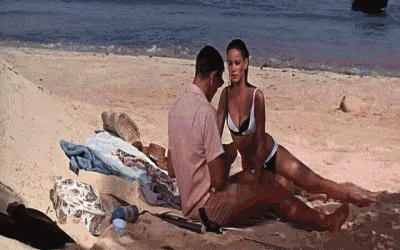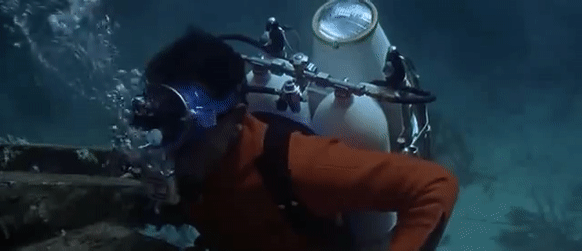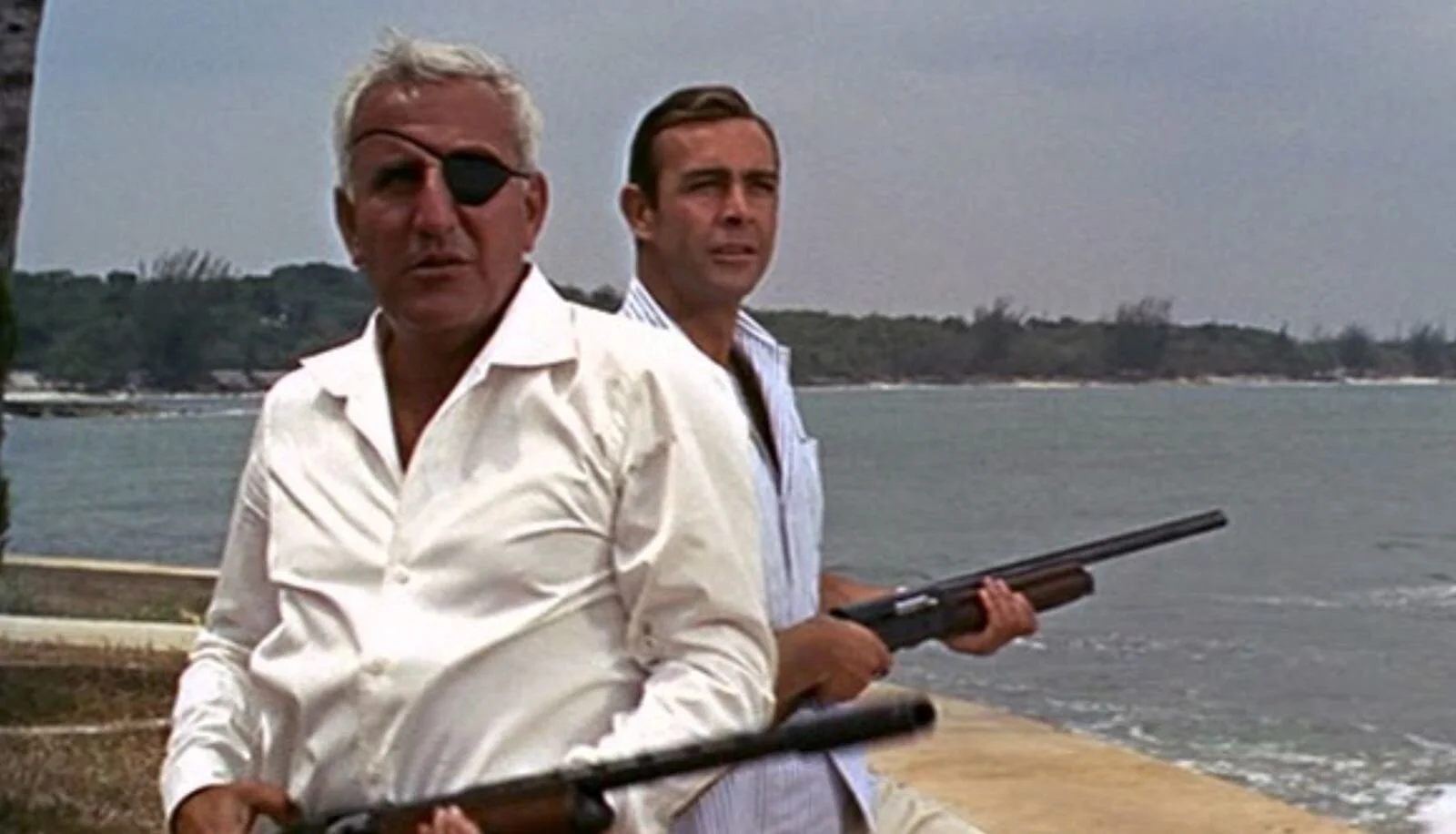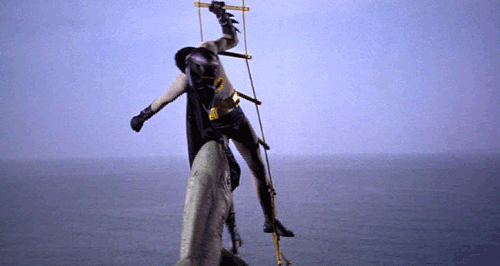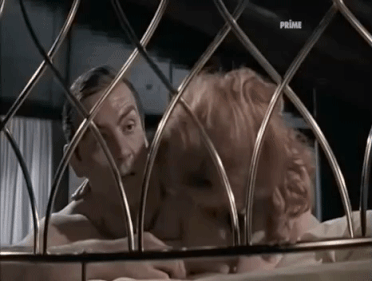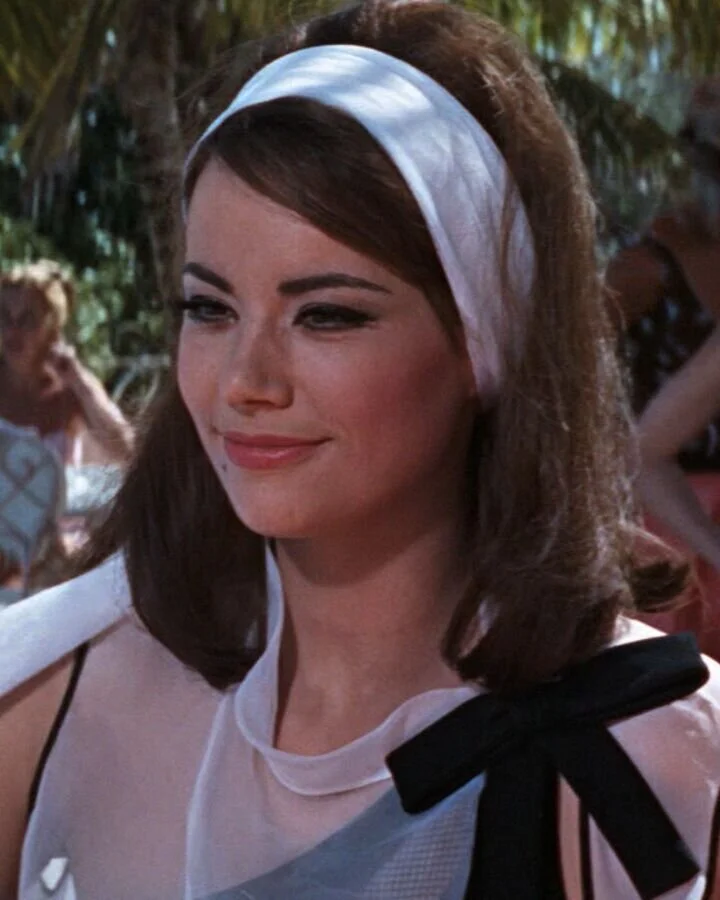Check out the accompanying Raven Bond podcast on Thunderball here!
Released: December 1965
Produced by: Kevin McClory (with Harry Saltzmann & Albert R Broccoli as executive producers)
Directed by: Terence Young
Written by: Richard Maibaum and John Hopkins
Plot:
Criminal organisation SPECTRE launches its boldest plan yet - stealing two nuclear weapons from a NATO plane and holding the world to ransom. James Bond gets himself sent to Nassau to follow a lead (aka, a pretty girl). He teams up once again with Felix Leiter to uncover more about the pretty girl, Domino, and her imposing millionaire lover/keeper Emile Largo.
Famous For:
SPECTRE’s giant war room with on-demand fiery death chairs
Oscar-winning underwater scenes and special effects
The first Bond film made in wide screen Panavision
The pre-credit sequence with THAT JETPACK
If you’d asked me to describe Thunderball before I rewatched it for this project, I would immediately have rated it highly. C’mon, it’s Thunderball. There’s a goddamn jetpack.
But sitting down to watch it again, with as critical an eye as I could muster, definitely reveals more flaws than I care to remember.
Billed as “the biggest Bond ever!” upon release, Thunderball is just that - more money, more danger, more girls, more explosions and more ravenous man-eating sharks kept as pets.
Unfortunately all that adds up to more bloat - somewhat apt, considering one-quarter of the film’s hefty 2 hours 10 minute running time is set underwater.
Is it OK, though?
The film looks glorious - its white-cool Caribbean beaches, sweeping helicopter shots and of course the submerged fight scenes show up beautifully on widescreen Panavision (a series first). But it really could do with an edit.
Thunderball is legendary for sparking a legal feud that really only wrapped up in 2012 with the acquisition by MGM and Danjaq of the rights to creative concepts such as SPECTRE and characters like Blofeld. Those elements had been included in an original story developed by Ian Fleming and writers Kevin McCrory and Jack Whittington with the aim of turning it into a movie.
When that flame was snuffed out, Fleming turned the idea into the 1961 novel Thunderball, and McCrory sued. It was the first book Eon producers Harry Saltzman and Albert R. Broccoli had wanted to adapt to film; but had to wait until a settlement was reached. That happened, Fleming died of a heart attack, and McCrory was brought onboard production. It’s why he was given sole producer credit, and rights to make another film of the story after 10 years (which he subsequently did with 1983’s Never Say Never Again).
The plot is relatively simple - SPECTRE steals two nuclear weapons from a NATO plane in an ambitious and complicated face-swap heist, and holds the world hostage for 100 million pounds. Bond goes to the Bahamas to foil the operation. But not even the novel; or one assumes, the original story fleshed out by Fleming, McCrory & co, is as overly loaded as the film.
One must assume screenwriters Richard Maibaum & John Hopkins had a key role in that; possibly egged on by Saltzman & Broccoli and that desire to outdo the three previous films in terms of derring-do. It’s also very possible our modern cinematic sensibilities - and reduced attention spans - find the extended surveillance scenes and underwater action sequences draining (haaaa, accidental pun).
Plus there’s squirrelly stuff going on with the timeline - SPECTRE is threatening to blow up a US or UK city within a week unless its ransom is paid, and Bond seems to have ample time to search the Bahamian coastline for signs of the plane that had been carrying the nuclear weapons, as well as engineer opportunities to encounter Domino and sneakily spy on Largo’s yacht the Disco Volante.
There are also contains a bunch of what appear to be scheduling bloopers, such as Domino telling Bond she and Largo are leaving “the day after tomorrow”, yet within seconds Bond agreeing to have lunch at Largo’s estate on “Sunday”. Which would be the earliest possible “day after tomorrow” the laws of time would generally allow, yet one would assume people about to leave a location to carry out an international war crime would be less likely to make lunch plans with a stranger.
Attempting to work out the timeline.
There are glorious moments in the film.
The pre-credit sequence, with Bond carefully watching the funeral of SPECTRE operative Jacques Bouvar, features that always-delightful Bond trope - snobbery. We saw it in From Russia With Love when Red Grant ordered red wine with fish; now, Bond recognises Bouvar’s “widow” is actually the Colonel himself in disguise. It means Bond greets the grieving “woman” with a punch to the face, and a jaunty “You shouldn’t have opened that car door yourself.” Because honestly, are we all born in barns?
Their knockdown, drag-out (sorry not sorry) fight ends with Bond strangling Bouvar, then rushing to a Bell Rocket Belt conveniently parked on the terrace outside. One assumes he must have used it to beat Bouvar back to his chateau, and somehow nobody noticed the smoky, noisy, fiery, airborne novelty engine blasting its way onto private property.
Still, it’s a goddamn jetpack, and I’m prepared to accept its presence, no matter how elastic the justification.
The local festival Junkanoo is brilliantly utilised - the first time, but by no means the last, that Bond films would capture local festivals and customs in its locations and use them both as a plot contrivance (generally for a chase/escape sequence) or at the very least of excellent travel advertising. Imagine sitting in a theatre somewhere in the cold British winter, seeing the riotous colour and exuberant movement of the Caribbean Junkanoo on screen. It crystallises more than any Bond film before the lushness of its locations; the escapist nature of the films from a dreary Western-centric life.
Of course Bond is a product of an Anglo-European identity, so the “exotic” nature of those traditions and cultures is through that framing. But I would still argue featuring real-life performers and participants helps pique interest in expanding one’s world view.
The Bond Bulletin points out this dog seems to wander into shot and relieve itself. That’s something all cultures and creeds can identify with.
M16’s cavernous briefing room in London is suitably impressive, equipped with tapestries that reveal massive screens and maps, and acoustics that allow Number One’s muted tones on tape to be heard by the assembled spies even though they’re 50 meters at least from the head table.
(Here’s a brief challenge - try to imagine Boris Johnson giving a briefing in that room. You can imagine any other British PM looking mostly capable, but BoJo? It’s impossible.)
Similarly, SPECTRE’s own Paris war room is a thing of beauty. You still cannot see Number One’s face, just the lap and lapcat. Operatives give their updates, including a beautiful Easter egg for true crime fans - the British agent details how SPECTRE made 250,000 pounds in consultant fees for the August 1963 Great Train Robbery. That’s about 10% of what the train robbers netted, so not insignificant.
“SPECTRE made the heist and my subsequent prison break & flight to Brazil a dream. Highly recommend.”
Number 11 is made to sweat when Number One says his narcotics profits have been embezzled… but then makes the switch and electrocutes Number Nine in his chair as the real guilty party. Several of the agents wipe their nervous brows, but Emile Largo barely notices, he’s so chill.
It’s such a fantastical super villain element, and again, brilliantly parodied by Austin Powers, with Will Ferrell as the hard-to-kill Mustafa.
Also enjoyable is the way Bond and Largo engage in spectacular cock-jousting machismo, while both pretending to be absolutely innocent parties who aren’t in any way a super spy and the second-in-command of the world’s most formidable terrorist organisation.
Largo is super rich, high status, has a sweet boat, and is clearly the superior eye-patch wearer, but Bond beats Largo at cards, at clay pigeon shooting, at escaping from henchmen and hungry sharks, and at scoring with Domino.
“Feeling cute. Might shag your ‘niece’ later.”
Largo keeps trying to kill Bond, resulting in more escapes for Bond than any of the other films. Previously Bond seemed to have two decent near-misses before the big survival at the end; think being clocked by Oddjob in Miami, then avoiding having his junk lasered in Switzerland in Goldfinger. In Thunderball, it’s almost laughable how many times Bond gets away from Largo, his goons - and his sharks! - then turns up again the next day acting all innocent.
I googled “Thunderball shark GIF” and this is what I got. Why did Q never think of shark repellant?
No wonder Largo is really f***ing pissed with Bond by the end.
Their smackdown battle in the cabin of the Disco Volante - it means Flying Saucer but sounds SO much cooler in Italian - is great hand-to-hand combat choreography, even if the speed ramping of footage behind them is distracting. And it’s great that Domino has the final shot - harpooning her tormentor and brother’s killer like a great white whale.
Fiona Volpe is an excellent henchwoman foil for Bond. A SPECTRE assassin who’s keeping an eye on Largo’s operation, she freaks 007 out with her self-assured speeding on the road back to Nassau (she conveniently picks him up after another Bond-escapes-death moment), then “accidentally” turns up in his bathtub and seduces him.
He’s already seen her SPECTRE ring and pinged she’s luring him into a trap, but what I love about Bond (which may signal something wrong with me?) is the way he lets it happen, because you might as well get on the job when you’re on the job.
He looks a bit… bored… in this GIF.
As they prepare to leave, and Bond finds henchmen with guns at the door, he throws out that old classic “I only slept with you because it’s my job, ha!” Volpe, to her credit, delivers a wonderfully stern rebuke to Bond, mocking his self-image as the man who “saves” dishonourable women with his magic penis.
It’s a fairly significant moment for the franchise, as while Pussy Galore had been a take-no-fools kind of babe, and saw Bond as mostly a shit-eating charmer who thinks he’s God’s gift to women, she still slept with him and helped save the day. Volpe’s reprimand is noteworthy because she sleeps with him first, then claps back to his “Doing it for England” excuse by basically saying the same thing - it was part of her job too, and mocks Bond for thinking his magical penis is a panacea for all “wayward” women. She may have screwed her brains out, but she’s still got her head screwed on.
Of course Bond responds with a jaunty “Well, you can’t win ‘em all”, but it foreshadows that winning the game of sexual Pokemon will not always be inevitable for him (see: Casino Royale).
It’s Volpe and Largo’s henchmen who chase Bond through the Junkanoo, shooting him in leg and causing Bond to be hampered, albeit briefly, in his escape. The scene culminates in Volpe finding him in a club and cutting in on the dance floor. It’s a wonderfully tense moment with great editing, cutting from the couple dancing, to the henchmen approaching from one side, and a mysterious hand with a gun emerging from a curtain near the band.
Bond flips Volpe around in time to use her as a human shield to take the bullet - because she resisted his magical penis, she must die. It is The Way Of Things. However he delivers the most bleak deadpan of the film when he drops her body in a chair and says “Never mind my friend, she’s just dead.” Ciao, bella. Amore ti amo.
We’ve mentioned Fiona Volpe, but let’s talk more about the other Bond girls.
Patricia is Bond’s therapist at Shrublands, the health centre where Bond recovers after killing Jacques Bouvar. She is a medical professional - and yet Bond just blatantly sexually harasses her during treatment. Things come to a head when she assumes responsibility for Bond’s back traction machine speeding up to “medieval torture” level (it was in fact, the villainous SPECTRE associate Count Lippe who flipped the switch).
Whatever you do, don’t picture this as Bond’s key sex move. You will not be able to un-see it.
Patricia turns it off, but pleads with him not to tell her boss, or she’ll lose her job. Bond smirks and says his silence would have a price, and then corrales her into the nearby steam room, where her crisp white uniform falls to the floor.
The tone is supposed to be “playful”, and Patricia is eventually seen to be a willing participant; hanging out in Bond’s room getting mink glove massages. But it’s uncomfortable to rewatch - setting aside the obvious workplace harassment angle, it also gives Bond a creepy predatory vibe that he shouldn’t have. Yes, Bond sleeps with younger women all the time, but they should be irresistibly drawn to him - or, as in Volpe’s case - because they’re doing the same thing he is.
Bond shouldn’t, I repeat, SHOULDN’T, come across as a dirty old man.
I googled “Dirty Old Man GIF” and got Gary Oldman. The algorithms, man.
Special mention to Paula Caplan, one of Bond’s almost blink-and-you’ll-miss-it local contacts, the other being Pinder. Paula has the thankless task of getting kidnapped by Volpe and chomping on a cyanide pill rather than spill any information during torture.
It’s a plot element that doesn’t bring the emotional payoff needed to justify its inclusion, as Bond hasn’t seemed to show a big rapport with her before she is snatched. Of course, he goes in search of her because he’s a loyal company man, but it’s mostly so he can have an action-packed shoot-out with Largo’s men at his Palmyra estate, and sets up Bond’s encounter with the pool sharks.
Yes. I did this. I have no regrets.
It’s also creates another weird problem in that Bond, who was watching the Junkanoo with Domino in town when Felix Leiter (the third actor in as many appearances to take on the role) turns up to tell him Paula has gone, then rushes off, leaving Felix to make sure Domino is safe and never returns. That didn’t prompt some questions? Largo’s men who seem to keep close tabs on her don’t intervene to see why this previously-unknown American turns up to stand alongside their bosses’ very protected “niece”?
But yes, Domino.
She’s very much more in the Tatiana Romanova vein of Bond girl - another pawn in SPECTRE’s international criminal chess game. Her brother Francois’ position as a NATO pilot was a key part of Largo’s plan to lift the nuclear weapons; he was murdered so that a two-bit crook who’d had plastic surgery could stand in as him and steal the plane carrying the bombs.
Domino is already miserable in her gilded-cage existence - scuba diving is her only escape from the watchful eyes of her minders. It’s where she first encounters Bond, who is conveniently underwater and close by when one of her fins gets stuck in coral.
Stylistically, Domino is possibly the most on-brand Bond girl of the franchise - her costumes are all black and white, just like the game her nickname is taken from. As the film progresses, the outfits move from mostly black (with the exception of her white casino dress), to black and white (in check or a mixed pattern) as she falls in love with Bond and decides to help him defeat Largo, until ultimately she is imprisoned on the Disco Volante in a pure white swimsuit. As Largo threatens to torture her until she reveals details of how she’s helped Bond, she really is the innocent victim at the mercy of a man who’s only interest in her is power and control over her body. It’s a nice flair that the character’s inner story is reflected in her outerwear.
Pictured: subtext.
It’s never quite explained, of course, how Bond manages to find Domino at exactly the right moment in exactly the right water off the exactly right deserted beach, while both are wearing exactly the right sort of diving gear for scuba sex. But hey, given Q turned up in Nassau with a bunch of absolutely-useful-on-this-mission gadgets, perhaps he slipped Bond some sort of tracking device. Some sort of application you can use to track your Dominos. If you don’t find them in 30 minutes, it’s free.
The logistics and physics of this, ahem, “search for sunken booty”, are also somewhat of a mystery. They’re not wearing wetsuits, sure, but there are so many other questions about buoyancy, and friction, and communication, and well, oh gosh, I mean, well, you know, how these things, errr, well… *conclude*, if you know what I mean.
Maybe Sebastian had other reasons to be so insistent life is much better down where it’s, ahem, wetter.
Thunderball concludes with those incredible underwater fighting sequences, which are really impressive, but which lose emotional punch the longer they go on because of the simple reason that it’s hard to see faces. We know the goodies (red wetsuits) versus the baddies (black wetsuits), and we can generally make out when Bond enters the fray because he’s got a turbo-charged propulsion unit strapped to his back, and eventually resorts to his pen-like breathing apparatus, but the bubbles and seaborne struggles become more like set dressing.
Bond manages to climb aboard the Disco Volante before it ramps up to its full 20 knots - ditching the back half to reveal a zippy hydrafoil on the front end. His men keep firing away despite the full forces of the US Coast Guard, or Navy, whatever, bearing down on them, and their boss having screwed them over to make his own getaway, so SPECTRE henchmen really are nothing if not loyal.
I’m glad Domino is the one who gets to kill Largo after his close cabin combat with Bond - she’d earlier pleaded with 007 to kill her keeper in revenge for the death of her brother, but having her stick him with the pointy end is very satisfying.
It’s also worth highlighting that Domino was set free by Kutze, a nuclear physicist working for SPECTRE who we see at various points through the film become more disillusioned with his employers. Like, they might not keep their promise to him that this would all resolve peaceably. He knows Domino is being tortured by Largo and frees her, the only redeeming act he can do at this point in proceedings.
After Largo is harpooned, and the boat speeds up so fast you need motion sickness medication to get through the last few minutes of the film, all three have to jump for the lives into the water. You see Kutze go in, but never again. He either drowns; or Bond and Domino just move on and get rescued without him. It’s very much up to you, the audience, to decide whether Kutze did enough to get a second chance at life.
Bond and Domino’s rescue is strangely abrupt: an inflatable life raft, a sky hook, and then a vertical trebuchet up to the rescue chopper. There’s not even a pun to be had.
I will always love Thunderball, because … well the best reason I have is “because it’s Thunderball”. For the first time in this retrospective process I’ve had to reckon with flaws that I don’t remember being as obvious. But that’s the thing about the Bond films; sometimes you just have to let your gut do the thinking.
Let’s end with this absolutely stunningly beautiful picture, which got me right in the gut feels:
From left to right that is Martine Beswick (Paula), Claudine Auger (Domino) and Luciana Paluzzi (Fiona Volpe).
Look at them! They are holding hands, smiling, walking through water! Beswick and Auger appear to be in costume swimsuits from the film; perhaps they got Paluzzi down to the beach one day to join them for some publicity pics. But I don’t get the feeling of manufactured laughs here; they radiate the warmth of the climate right out of the frame. The film may not pass the Bechdel test (the one conversation two women - Paula and Volpe - have is about Bond), but damn, there’s more than unites Bond girls than divides them. If they’d all worked together, Bond, Largo, SPECTRE, the lot of ‘em would be toast.
As a final bit of silliness, I love the way Sean Connery’s accent makes “Nassau” and “No sir” sound virtually identical. It makes me wish his personal mission briefing for Operation Thunderball went a bit more Abbott & Costello:
M: I’m sending you to Canada, 007.
Bond: Nassau?
M: You can’t refuse me, I’m your superior!
Bond: Yes sir, but Nassau.
M: Are you mocking me?
Bond: No sir.
M: Then where do you want to go?
Bond: The Bahamas.
M: Nassau?
Bond: Yes sir.
M: Are you certain the bombs are in Nassau?
Bond: No sir.
M: That’s what I said.
Bond: No sir, I’m not certain the bombs are in Nassau. But it’s worth following up.
M: All right, Nassau.
Bond: Nassau.
M: WHAT NOW 007?!?!?!
Thank you for reading this instalment of the James Bond Retrospective! If you enjoyed it, you can sign up to support the series and my other writing/podcasting efforts via my Patreon page. Thanks to all of you who are already members; your support is truly invaluable.
You can listen to the companion Raven Bond Thunderball podcast here:
Stu and I have are also ranking the Bond films as we watch and podcast about them. Here’s how we stand:
See you next time for You Only Live Twice!
